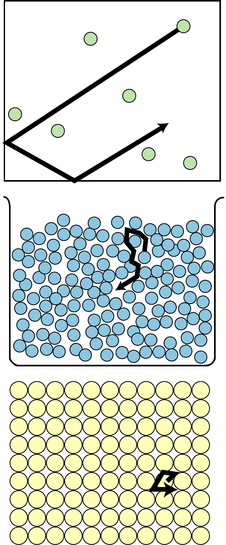LM 12.1 Heat is kinetic energy Collection
12.1 Heat is kinetic energy by Benjamin Crowell, Light and Matter licensed under the Creative Commons Attribution-ShareAlike license.
12.1 Heat is kinetic energy
What is heat really? Is it an invisible fluid that your bare feet soak up from a hot sidewalk? Can one ever remove all the heat from an object? Is there a maximum to the temperature scale?
The theory of heat as a fluid seemed to explain why colder objects absorbed heat from hotter ones, but once it became clear that heat was a form of energy, it began to seem unlikely that a material substance could transform itself into and out of all those other forms of energy like motion or light. For instance, a compost pile gets hot, and we describe this as a case where, through the action of bacteria, chemical energy stored in the plant cuttings is transformed into heat energy. The heating occurs even if there is no nearby warmer object that could have been leaking “heat fluid” into the pile.

b / Random motion of atoms in a gas, a liquid, and a solid.
An alternative interpretation of heat was suggested by the theory that matter is made of atoms. Since gases are thousands of times less dense than solids or liquids, the atoms (or clusters of atoms called molecules) in a gas must be far apart. In that case, what is keeping all the air molecules from settling into a thin film on the floor of the room in which you are reading this book? The simplest explanation is that they are moving very rapidly, continually ricocheting off of the floor, walls, and ceiling. Though bizarre, the cloud-of-bullets image of a gas did give a natural explanation for the surprising ability of something as tenuous as a gas to exert huge forces. Your car's tires can hold it up because you have pumped extra molecules into them. The inside of the tire gets hit by molecules more often than the outside, forcing it to stretch and stiffen.
The outward forces of the air in your car's tires increase even further when you drive on the freeway for a while, heating up the rubber and the air inside. This type of observation leads naturally to the conclusion that hotter matter differs from colder in that its atoms' random motion is more rapid. In a liquid, the motion could be visualized as people in a milling crowd shoving past each other more quickly. In a solid, where the atoms are packed together, the motion is a random vibration of each atom as it knocks against its neighbors.
We thus achieve a great simplification in the theory of heat. Heat is simply a form of kinetic energy, the total kinetic energy of random motion of all the atoms in an object. With this new understanding, it becomes possible to answer at one stroke the questions posed at the beginning of the section. Yes, it is at least theoretically possible to remove all the heat from an object. The coldest possible temperature, known as absolute zero, is that at which all the atoms have zero velocity, so that their kinetic energies, `(1"/"2)mv^2`, are all zero. No, there is no maximum amount of heat that a certain quantity of matter can have, and no maximum to the temperature scale, since arbitrarily large values of `v` can create arbitrarily large amounts of kinetic energy per atom.
The kinetic theory of heat also provides a simple explanation of the true nature of temperature. Temperature is a measure of the amount of energy per molecule, whereas heat is the total amount of energy possessed by all the molecules in an object.
There is an entire branch of physics, called thermodynamics, that deals with heat and temperature and forms the basis for technologies such as refrigeration. Thermodynamics is discussed in more detail in optional chapter 16, and I have provided here only a brief overview of the thermodynamic concepts that relate directly to energy, glossing over at least one point that would be dealt with more carefully in a thermodynamics course: it is really only true for a gas that all the heat is in the form of kinetic energy. In solids and liquids, the atoms are close enough to each other to exert intense electrical forces on each other, and there is therefore another type of energy involved, the energy associated with the atoms' distances from each other. Strictly speaking, heat energy is defined not as energy associated with random motion of molecules but as any form of energy that can be conducted between objects in contact, without any force.
12.1 Heat is kinetic energy by Benjamin Crowell, Light and Matter licensed under the Creative Commons Attribution-ShareAlike license.
Calculators and Collections
Equations
- Kinetic Energy KurtHeckman Use Equation
- Comments
- Attachments
- Stats
No comments |
